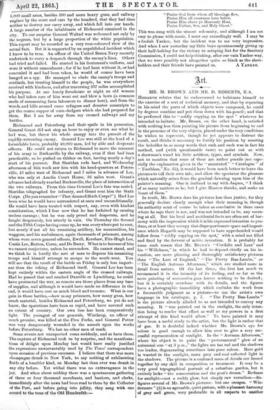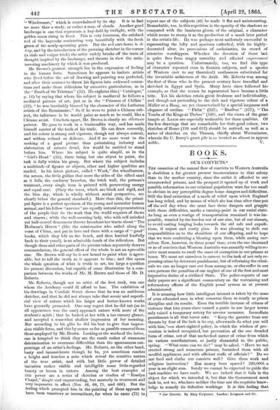Art.
MR. M. BROWN AND MR. D. ROBERTS, MA.
HOGARTH relates that he endeavoured to habituate himself to the exercise of a sort of technical memory, and that by repeating
in his mind the parts of which objects were composed, he could by degrees combine and put them down with his pencil ; and that he preferred this to "coldly copying on the spot" whatever he intended to imitate. Mr. Brown, on the other hand, is satisfied with nothing less than painting his picture from beginning to end in the presence of the very objects, placed under the very conditions he wishes to represent, though he yet appears to distrust the result, and thinks it necessary to fortify his position by assuring the beholder in so many words that such and such was in fact his method, and (with questionable taste) to point out as with a showman's wand his little artifices, types, and symbols. Now, not to mention that some of these are rather puerile (see espe- cially the explanation given in the " annotated " " Catalogue " of "Toothless," No. 35), it would have been much better to leave the pictures to tell their own tale, and allow the spectator the pleasure which naturally arises from the gradual dawning upon him of the painter's meaning. One is inclined to say with Jaques, "I think of as many matters as he, but I give Heaven thanks, and make no boast of them."
In truth, Mr. Brown does his pictures less than justice, for they generally declare clearly enough what their meaning is, though his authority must of course be taken as conclusive in those cases where he says there is not, and was not intended to be, any mean- ing at all. But his local and accidental facts are often out of har- mony with the impression which it is his expressed intention to pro- duce, or at least they occupy that disproportionate space and import- ance which Hogarth may be supposed to have apprehended would follow from "coldly copying on the spot," with a mind not filled and fired by the fervour of active invention. It is probably for some such reason that Mr. Brown's " Cordelia and Lear" and his " Willelmus," in which he had to depend chiefly on his in- vention, are more pleasing and thoroughly satisfactory pictures than "The Last of England," "The Pretty Baa-Lambs," or "The English Autumn Afternoon," which are studied more in detail from nature. Of the last three, the first has much to recommend it in the intensity of its feeling, and so far as the mere painting of accessories goes leaves nothing to be desired ; but it is certainly overdone with its details, and the figures have a photographic immobility which excludes the work from a favourable judgment as a picture—to use the artist's own language in his catalogue, p. 7. "The Pretty Baa-Lambs " is the picture already alluded to as not intended to convey any meaning. It "was painted out in the sunlight, the only inten- tion being to render that effect as well as my powers in a first attempt of this kind would allow." To have painted it may have been a useful study to the artist, but the light is rather that of gas. It is doubtful indeed whether Mr. Brown's eye for colour is good enough to allow him ever to give a very suc- cessful representation of sunlight. In the "Autumn Afternoon," where his object is to paint the " preternatural " glow of an autumnal sun "at 3 p.m.," the lights are too red and the shadows too leaden, degenerating sometimes into puce colour. More gold is wanted in the sunlight, more grey and cool reflected light in the shadows. The picture is a confused mass of details not bound together by any skill in composition or treatment. It may be a very good topographical portrait of a suburban garden, but it entirely lacks "the consecration and the poet's dream." Redness for sunlight—not a ruddy glow, but simply raw vermilion--dis- figures several of Mr. Brown's pictures : but one escapes. " Win- dermere " (5) is an agreeable, quiet picture, with a pleasant harmony of grey and green, very preferable in all respects to another "Windermere," which is overwhelmed by its sky. It is in fact no more than a study, or rather a map, of clouds. Another good landscape is one that represents a hay-field by twilight, with the golden moon rising in front. This is very luminous, the subdued red of the haycocks contrasting very beautifully with the fresh green of the newly-sprouting grass. But the red cart-horse is de trap, and by the introduction of the yawning sketcher in the corner (a stale and vulgar trick) the artist rudely breaks off the train of thought inspired by the landscape, and thrusts in view the unin- teresting machinery by which it was produced. Mr. Brown's greatest strength lies in the expression of feeling in the human form. Sometimes he appears to imitate artists who lived before the art of drawing and painting was perfected, and after their manner to throw his figures into awkward contor- tions and make them ridiculous by excessive gesticulation, as in the "Death of Sir Tristram" (32). He explains this (" Catalogue," p. 14) by saying that where his subject is medimval he follows a medimval pattern of art, just as in the "Prisoner of Chillon " (22), "he was inevitably biassed by the character of the Lutheran artists of the Renaissance." So if he were to paint a Chinese sub- ject, the inference is he would paint as much as he could, like a Chinese artist. Crochets apart, Mr. Brown is clearly no dilettante painter. He goes to work in a businesslike way, and has made himself master of the tools of his trade. He can draw correctly, and his colour is strong and vigorous, though not always correct, and seldom refined or delicate. And if no more went to the making of a good picture than painstaking industry and elaboration of minute detail, few would be entitled to stand before him. Where his subject is quite simple', as in the "Girl's Head" (35), there being but one object to paint, the task is fully within his grasp. But where the subject includes a multitude of figures or objects, other and higher qualities are needed. In his latest picture, called "Work," the wheelbarrow, the screen, the little gullies that score the sides of the sifted sand as it falls, the corduroy breeches, the brick wall, the potman's waistcoat, every single item is painted with persevering energy and equal care. (Only the trees, which are black and rigid, and the blue sky, which is wholly without aerial perspective, are clearly below the general standard.) More than this, the princi- pal figure is a perfect specimen of the young and muscular human animal, and his fellow "navvies" are equally natural representatives of the people that do the work that the world requires of thews and sinews ; while the well-meaning lady, who with self-satisfied yet half-scared demeanour throws broadcast her tracts about "The Hodman's Haven" (like the missionaries who sailed along the coast of China, and put in here and there with a cargo of "good" books, which they left on the beach, and then hurried fearfully back to their vessel), is an admirable touch of the ridiculous. But though these and other parts of the picture taken separately deserve commendation, the general effect of the whole is not an agreeable one. Mr. Brown will say he is not bound to paint what is agree- able, but to tell the truth as it appears to him ; and this opens the whole question of what is truth in art, too large a question for present discussion, but capable of some illustration by a com- parison between the works of Mr. M. Brown and those of Mr. D. Roberts.
Mr. Roberts, though not an artist of the first rank, was one whom the Academy could ill afford to lose. The exhibition of his drawings in Conduit Street shows that he was an assiduous sketcher, and that he did not always take that scenic and superfi- cial view of nature which his larger and better-known works have generally presented. One may regret that he did not (as to all appearance was the case) approach nature with more of the student's spirit ; that he looked at her with a too cursory glance, and accepted a somewhat shallow impression of her meaning. But according to his gifts he did his best to give that impres- sion visible form, and this by means as far as possible removed from those employed by Mr. Brown. Looking at the works of the latter, one is tempted to think they are the result rather of strenuous determination to overcome difficulties than the spontaneous out- pourings of an artist's feelings. Mr. Roberts, on the other hand, hasty and inconsiderate though he be, yet sometimes reaches a height and touches a note which reveal the sensitive nature of the true artist, and with but little power of detailed imitation makes visible and intelligible some little-regarded beauty or lesson in nature. Among the best examples of this power are a aeries of sketches or studies of "Rosalyn Chapel," simple and unpretending, but masterly in treatment and very impressive in effect (Nos. 46, 68, 71, and 466). But the feeling which prompted him in the painting of them appears to have been transitory or intermittent, for when he came (75) to repeat one of the subjects (46) he made it flat and uninteresting. Remarkable, too, in this repetition is the opacity of the shadows as compared with the luminous gloom of the original, a character which seems to stamp it as the production of a much later period in the artist's life. He was perhaps most uniformly successful in representing the lofty and spacious cathedral, with its highly- decorated altar, its processions of ecclesiastics, its crowd of attentive worshippers. Whether the devotion of these last is quite free from stagey unreality and affected empressment may be a question. Unfortunately, too, we find this type of character repeated even in Eastern subjects, and a species of Western (not to say theatrical) restlessness substituted for the invariable sedateness of the Arab. Mr. Roberta was among the first of those who in the present century have travelled and sketched in Egypt and Syria. Many have since followed his example, so that the scenes he represented have become a little trite. Yet his sketches retain great freshness and individuality, and though not pretending to the rich and vigorous colour of a Muller or a Haag, are yet characterized by a special largeness and elegance of outline. " Philre " (327), " Baalbec " (277), "The Tombs of the Kings at Thebes" (160), and the views of the great temple at Luxor are especially noticeable for those qualities. Of the few drawings that are remarkable for their good colour, two sketches of Rome (199 and 613) should be noticed, as well as a series of sketches on the Thames, chiefly about Westminster, wherein Sir C. Barry's great pile is so treated as almost to appear































 Previous page
Previous page